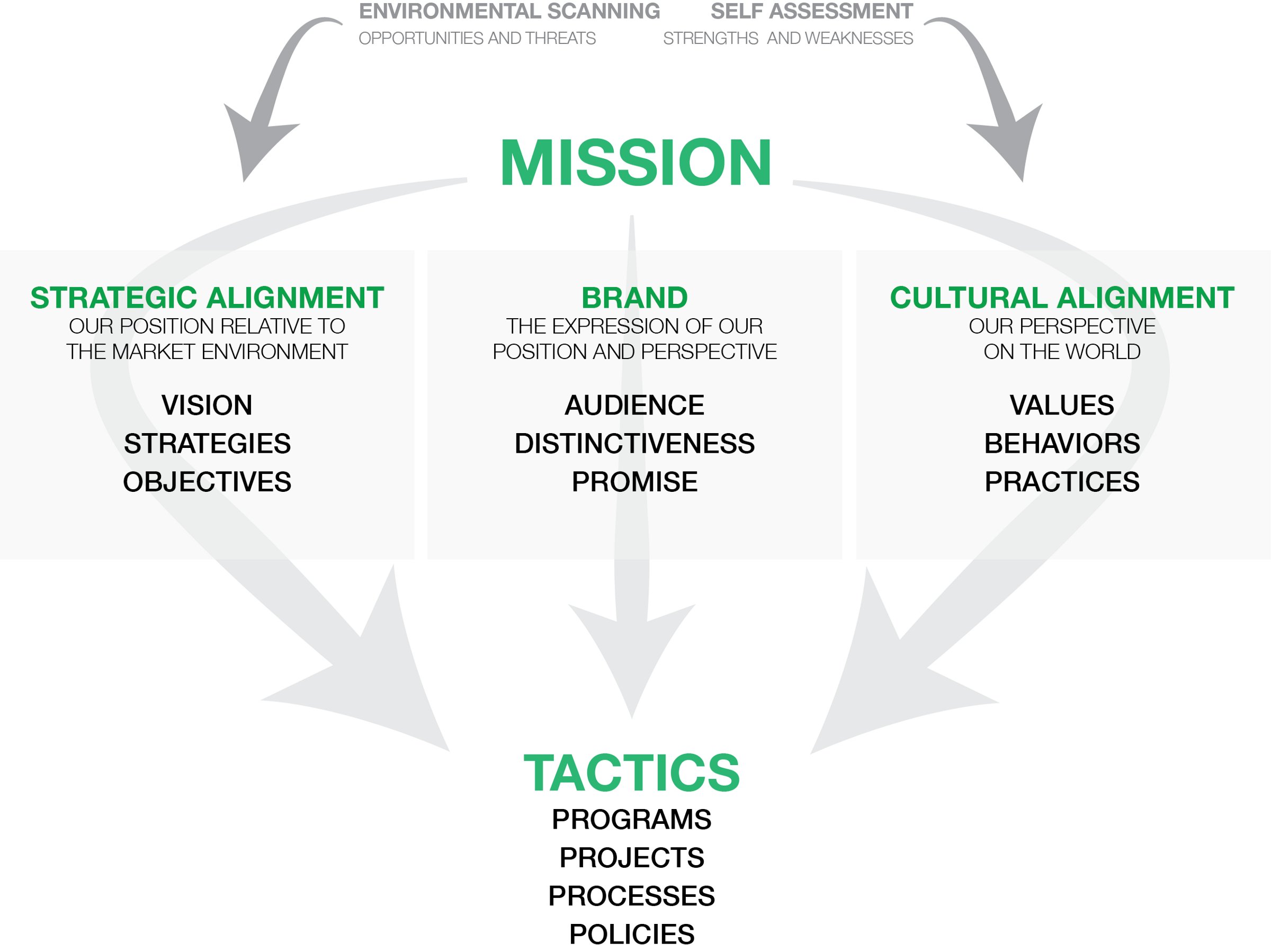A Unified Planning Framework for Culture, Strategy, and Brand
At many non-profit institutions, particularly educational institutions, strategic plans show a preference for addition over consolidation—for expansion over alignment. This programmatic and operational accretion drives steady increases in budgets and staffing, and concomitant growth in goals for endowments and annual philanthropic support.
Higher Cost, Slower Pace = Unaffordable Schools
This resource-hungry model of planning not only increases the cost of school, but also promotes a slow pace. At schools, typical strategic planning efforts take 18 to 24 months and involve a huge number of people. (Surprise surprise: with “unlimited” resources comes unlimited desires, which all must be heard, sorted, and prioritized.) The resulting plan governs institutional decisions for five to seven years. A capital campaign comes on the heels of the strategic plan, with about two years of “quiet phase” followed by four or five years of “public phase.” The process repeats again after some period of rest. This cycle creates an interval of approximately a decade between planning cycles—an eternity in today’s marketplace.
The tendency for a traditional strategic planning processes to focus on expansion is an innate and disadvantageous bias.
The slow, traditional approach to strategic planning requires resources that are too great and timelines that are too long— especially now, when the competitive, regulatory, cultural, and market context is changing rapidly for every institution.
If alarm bells aren’t already sounding at your school, just wait. While traditional time- and dollar-intensive strategic planning continues to (just-barely) work at institutions that have been blessed with ample resources, the disruptive pressures and trends we face in today’s marketplace are already affecting more mainstream institutions. Soon, these factors will impact the elites as well.
All institutions must become more efficient, more nimble, and more capable of facing emerging challenges in today’s shifting landscape — and that begins with a new model and approach to the strategic planning process itself.
A Framework for Organizational Alignment
Today, we need systems driven in shorter cycles — leaving behind the larger, longer, slower planning tradition. We should focus on consistent, iterative changes and increased organizational cadence. And we should emphasize the redirection and coordination of resources over the desire for more. To faciliate this approach to planning, it helps to envision the organization through three critical facets of strategic, cultural, and brand goals, each of which operates at three levels of scale:
- Strategy orients the business model of the institution to the current market and environment, leveraging available opportunities and defending against possible threats.
- Culture guides and encourage behaviors and practices through shared values. In many ways, culture defines an institution’s “approach” to strategic objectives.
- Brand expresses both Strategic and Cultural aspects of the institution, providing a clear messages around which all prospects and stakeholders can coordinate.

Spend some time with this diagram. To respond to the changing needs of the market, we must have a clear center from which to align tactics against future challenges and, ultimately, Mission. At the top of the diagram are the fundamental elements of self assessment (internal) and environmental scanning (external); these two inputs—which you may recognize as SWOT—should be constant drumbeats for the organization and should serve as its breath and heartbeat.
Mission captures an organizations’s timeless spirit, and the rest of the diagram is what brings that spirit to life. As you move downward through the three boxed items in the middle of the diagram, timescales begin to shorten. While Mission rarely changes, items at the bottom of each of these boxes benefit from annual adjustment.
The tactics at the bottom are daily actions of the organization, improved and adjusted “on the ground,” every day. While many orgs are attracted to the bright lures of “strategery,” tactics, and tactics alone, bring a plan to life.Your mission must be linked to everyday tactics, and the three channels of culture, strategy, and brand, are a powerful framework for facilitating these connections.
The model outlined above takes the huge, unwieldy notion of organizational planning and provides three useful handholds for alignment and action—and the timescales implied here contemplate planning cycles far more relevant and responsive to the daily, quarterly, and annual patterns in which our organizations actually operate. In each of these pieces and parts, an organization can make iterative improvements, banishing the notion that planning is a once-a-decade process, reducing “change through addition,” and bringing greater agility.